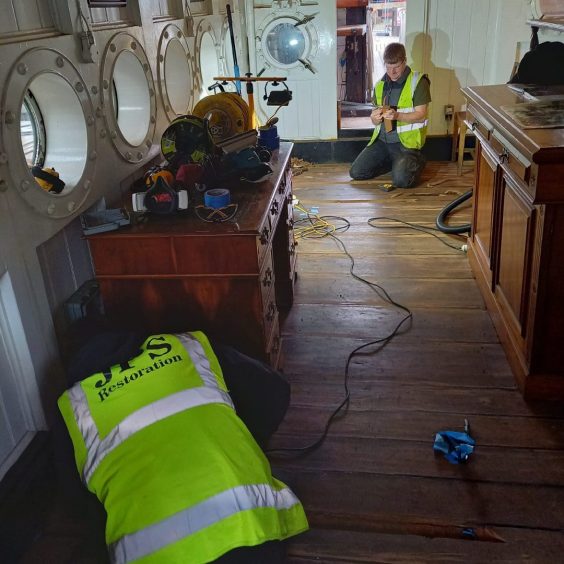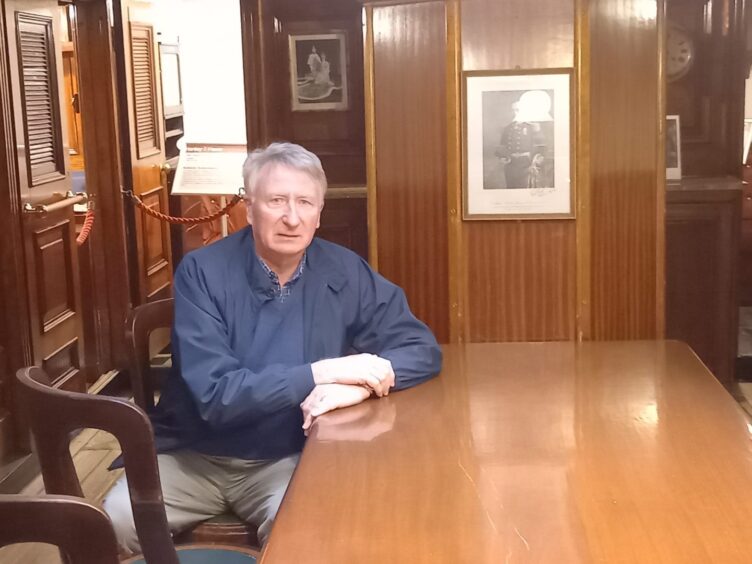Dundee Heritage Trust chairman David Henry is bathing in the afterglow of international media coverage when we stop in front of a poignant memorial to polar explorer Sir Ernest Shackleton.
Standing three metres (9.84 ft) tall, the Hope Cross has travelled more than 7,000 miles from Shackleton’s resting place in South Georgia to Dundee.
It now stands yards from the legendary RRS Discovery, symbolising a poignant connection between Dundee and Shackleton’s heroic feats.
Shackleton died in 1922 in South Georgia during his final expedition aboard the Quest.
The Hope Cross was constructed by crew members who could not attend his funeral.
Its unveiling at Discovery Point coincides with the release of a new documentary on Shackleton’s doomed 1916 Endurance expedition and the 2022 hunt for the sunken vessel, as previously featured in The Courier.
A Shackleton festival, organised by the Perth-based Royal Scottish Geographical Society and the trust, is taking place at the Caird Hall on December 5.
But just as Shackleton’s dramatic tales of survival against insurmountable odds is rekindling global imaginations, Shackleton’s approach to leadership, courage and risk-taking is also inspiring Dundee Heritage Trust to weather its own financial storm.
What are the financial challenges facing Dundee Heritage Trust and RRS Discovery?
“Dundee Heritage Trust and the RRS Discovery have symbolised the renaissance of Dundee for over 30 years,” says Mr Henry, a former pupil of Blackness Primary School and Harris Academy.
“However, I don’t think people appreciate the enormous impact the ship has had – both in terms of drawing tens of thousands of visitors every year and the millions of pounds it brings into the Dundee and Scottish economies.”
The trust, which operates as a free-standing charity, is feeling the pinch of rising costs and post-Covid-19 financial pressures.
There’s a misconception, says Henry, that the RRS Discovery and the trust’s museums are run by the local council.
However, he says they are as vulnerable to the winds of economic change as any other business – and it would be “disingenuous” to suggest otherwise.
“Just like Shackleton, we are facing challenges,” he says.
“But as Shackleton used to say, ‘there’s always one more move.’ We are not at the end of the game yet!”
Asked about the financial challenges facing Dundee Heritage Trust, Mr Henry said he “can’t go into it too much”.
But the key point, he says, is there’s a “big difference between capital and revenue”.
With over 98% of its funding coming from ticket sales, grants, fundraising, and hospitality, the trust is tasked with not only caring for the RRS Discovery but also maintaining an annual operating budget of around £2 million.
The cost of heritage care alone stands at £1.3m, making it a constant balancing act to meet these financial demands while ensuring the ship remains preserved for future generations.
RRS Discovery is more than just ‘Captain Scott’s Ship’
Ever since the RRS Discovery returned to Dundee in 1986, it has been widely recognised as ‘Captain Scott’s ship,’ given its role in taking Captain Robert Falcon Scott and his crew, including Shackleton, to Antarctica in 1901.
However, in recent years, it is Shackleton’s remarkable connections to Dundee that have been gaining prominence.
As vital restoration work continues on the RRS Discovery, Mr Henry and the Dundee Heritage Trust have a long-term vision to breathe new life into the ship’s story.
The goal is to shift the narrative, appealing to an even broader audience by highlighting the RRS Discovery’s lesser-known scientific function and its relevance to modern-day climate change research.
“For local people, it’s about the pride in the shipbuilding heritage and the explorers who sailed her,” Henry explains.
“But international visitors may not have the same connection to Dundee’s history. We’re looking to refresh the story by focusing on common themes like climate change and the state of our oceans, which resonate globally.”
This approach has the potential to engage a wider audience, drawing in visitors who may not be familiar with the specifics of British maritime history but are keenly aware of contemporary issues affecting the planet.
What are Dundee Heritage Trust’s ambitious plans for Discovery Point?
Dundee Heritage Trust’s ambitions don’t stop with the RRS Discovery’s restoration.
Plans are also underway to revamp the galleries at Discovery Point, enhancing the visitor experience and incorporating new technology to tell more stories about the ship’s past and its ongoing legacy.
One exciting development is the potential for an app-based display showing the real-time location and activities of modern research vessels, including the RRS Discovery II, which visited the city last year, and the RRS Sir David Attenborough.
Mr Henry is eager to highlight the pioneering nature of the original RRS Discovery as a research vessel in the 1920s, particularly in its role in understanding the world’s oceans and climate.
“We want to bring this story more to the fore, connecting it with the work of today’s vessels, which are leading similar scientific research,” he says.
“In a way, it complements the ideas behind the Eden Project in Dundee.”
Restoring the RRS Discovery
Visitors to Dundee can see first hand the restoration work underway on the RRS Discovery.
Skilled local craftsmen are working tirelessly to ensure the ship is preserved for future generations.
A recent highlight was the acquisition of two antique teak logs from the SS Pegu, which was torpedoed by a German U-boat during World War I.
These rare teak logs provide the trust with high-quality materials to replace some of the ship’s rotting timbers, without further depleting teak forests.
The restoration process is intricate and delicate.
The ship, now in dry dock and effectively sealed in during construction of V&A Dundee, is being held in place by a yellow steel frame as structural timbers in the hull are carefully replaced.
“The next stage is to make the hull wind and weather tight,” Henry explains, “to prevent further water ingress.”
Once this crucial stage is complete, the plan is to place a cradle at the bottom of the dock to re-float the ship.
This step is vital for both structural integrity and preservation, as water helps counteract the detrimental effects of gravity on the bow and stern.
“We want to ensure that the ship is still in good condition 100 years from now,” Henry says, underscoring the long-term vision behind the restoration effort.
A collaborative effort to secure the future
When asked if there is a threat to the long-term future of the RRS Discovery, Henry acknowledges the challenges but remains optimistic.
“There’s always a threat – like any organisation, we stand and fall by our paying customers,” he says.
“But with the support of the local communities, city council leadership, MPs, and MSPs, we are working hard to overcome these challenges.”
Mr Henry emphasises that the effort to preserve the RRS Discovery is a collaborative one.
As work continues to restore the ship, he’d encourage as many people from the Dundee and surrounding area as possible to “rediscover the Discovery”.
“There’s a genuine sense of ‘Team Dundee’ here,” he adds.
“The trust isn’t in competition with other local attractions like the HMS Unicorn.
“Instead, they complement each other, drawing visitors to Dundee and encouraging them to explore the city’s rich cultural and historical offerings.”



















Conversation